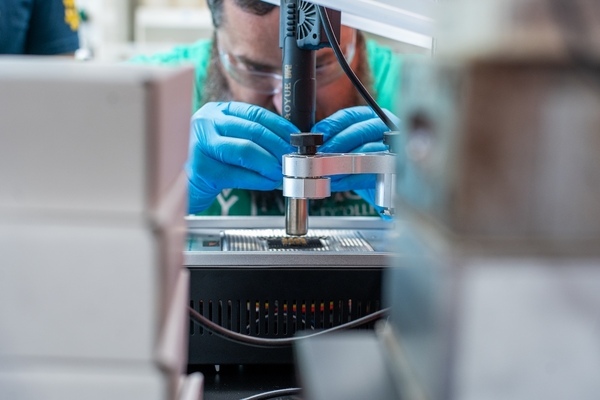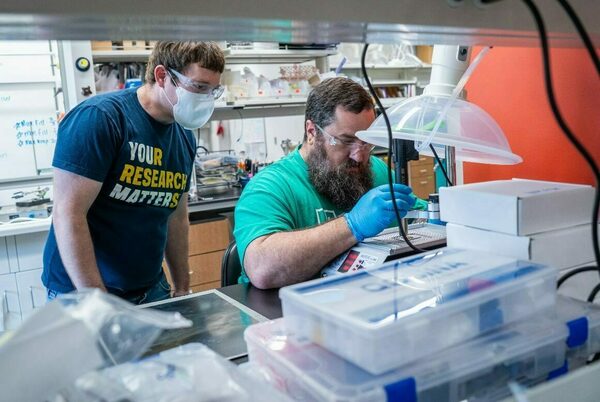Ivy Tech professors amp up their AC game at Notre Dame
This story was originally published by Notre Dame Research
Ivy Tech professors amp up their AC game at Notre Dame
From discovering novel ways to purify and reuse chemicals to creating sensors that will make cooling systems safer and more cost-efficient, teams of researchers have been working together this summer to modernize a sector many take for granted: the heating, ventilation, air conditioning, and refrigeration industry.
Indeed, HVACR is essential to every aspect of modern life. To move it forward, two professors from Ivy Tech, a community college with 45 locations in Indiana, spent a large part of their summer in a lab. Through a Research Experiences for Teachers (RET) program, they had the opportunity to join ongoing projects led by faculty and graduate students at the University of Notre Dame.
“It’s been an excellent learning experience, and I’ll be able to replicate most of what we did with my own students,” said William Slonaker, Department Chair and Assistant Professor of HVAC and Building Construction at Ivy Tech’s Kokomo campus, and one of the two Ivy Tech participants this summer.
The four-week RET program was made possible by EARTH, the Environmentally Applied Refrigerant Technology Hub, an Engineering Research Center funded by the National Science Foundation. Through EARTH’s industry consortium members, the center also receives financial support from U.S. companies seeking to accelerate the development and commercialization of innovative technologies in the HVACR sector, including next-generation refrigerants and advanced cooling systems.
EARTH is led by the University of Kansas (KU) and also involves professors, staff and students from Notre Dame, Lehigh University, University of Maryland, University of Hawai’i, and University of South Dakota.
HVACR systems are critical to global infrastructure, yet traditional refrigerants – the chemicals that cool everything from air and food to data centers – pose environmental hazards. The research collaborators, brought together by EARTH, are working to create advances that will improve the lives of people around the world and make HVACR systems run more efficiently, ultimately reducing heating and cooling costs for households and businesses.
EARTH Education Director Casey Williams, who is based at University of Kansas, directed the summer’s RET program. KU and the University of Maryland also hosted community college professors and high school teachers, respectively, he said.
“The collaboration between Notre Dame and Ivy Tech is helping to achieve EARTH’s goals on many levels,” Williams said. “From creating new materials in the Notre Dame lab, making plans to test them at Ivy Tech, and preparing to discuss these innovations with American companies – you couldn’t ask for a more successful program.”
Separating the good from the bad

Slonaker’s research supported the first of EARTH’s three research thrusts: Reclaim and Repurpose. One of the main goals of this thrust is the development of new polymers to stop the venting of millions of metric tons of refrigerants.
“We’re researching new processes for refrigerant reclamation,” Slonaker said. “Current separation methods, relying on distillation columns and boiling temperatures as high as 170-180 degrees Celsius, are extremely energy-intensive. We wanted to find a more efficient approach.”
Slonaker and his Notre Dame colleagues followed a complex process of adding and removing liquids, creating powders, and then redissolving them to cast incredibly thin, yellow, opaque discs, or membranes. The polymer devices – just 0.008 millimeters thick – are designed with molecular-sized holes, allowing specific chemicals to pass through while holding others back.
The ones that pass through could then be used as raw materials for other chemical compounds and products of interest to EARTH’s industry consortium members. These processes, at scale, would support EARTH’s overarching objective – the development of a circular refrigerant economy that would be just as good for the planet as for business.
Slonaker worked in a lab managed by Notre Dame Professor of Chemical and Biomolecular Engineering Ruilan Guo.
“We are developing and testing a new class of polymer membranes specifically tailored for refrigerant separations and recycling, demonstrating highly promising performance with both high permeability, productivity and selectivity as well as excellent chemical and mechanical durability, overcoming key limitations of existing membrane materials,” Guo said. “This advancement has the potential to transform the HVACR industry by enabling highly energy-efficient, cost-effective, and environmentally sustainable refrigerant recovery and reuse processes.”
Like a sommelier’s nose
Ivy Tech South Bend Faculty Fellow Paul Downing also participated in the RET program.
He said he has a new appreciation for Notre Dame’s iconic campus. Although he had driven by campus many times, he had never been inside the Basilica of the Sacred Heart or walked up to the Golden Dome until this summer.
“The pictures don’t do it justice,” Downing said. “I feel so lucky to have spent the summer at Notre Dame, researching ways to modernize the HVACR industry.”

Downing’s work played into EARTH’s third research thrust: Energy Efficient Systems, which include the development of electronic sensors to address refrigerant leakage.
Leaks are a more serious issue than many people may realize: up to 90% of liquid refrigerant leaks and evaporates over the lifetime of HVACR equipment. Refrigerants are greenhouse gases, which are dangerous for the environment.
Jennifer L. Schaefer, Sheehan Family Collegiate Professor of Engineering at Notre Dame, explained how refrigerants enter the atmosphere.
“This happens due to a combination of venting – purposeful leaking, which we are trying to address via Bill Slonaker’s project – and accidental leaking, which we are trying to mitigate by sensors that detect leaks before the system has lost so much refrigerant that the performance tanks,” said Schaefer, who is also EARTH’s Deputy Director. “These inefficiencies increase the amount of electricity used for the same amount of cooling, driving up energy costs.”
Downing followed a meticulous process, hand-soldering 1,656 minuscule pins onto 30 circuit boards, which function like tiny computers.
Sensing technology itself is not entirely new, but the metal oxide semiconductor sensors in development at Notre Dame are being designed to offer far greater precision, said Downing, adding that the sensors would be able to fit inside ductwork that transports air.
Downing likened the technology to a trained sommelier who identifies distinct notes in a wine. Just as the human brain records and recognizes the smell of cherry or oak in a cabernet, the lab sensors can "smell" odorless refrigerants by detecting changes in electrical resistance as air passes over them.
“The reason that's important now, compared to the past, is that we're using mildly flammable refrigerants,” said Downing, noting that hydrofluorocarbons have replaced chlorine-based refrigerants, which have been banned.
Research: fueling America’s economic competitiveness

Research on the sensors will continue this academic school year. Once commercialized, they could simplify troubleshooting and communication between manufacturers of air-conditioning systems and their customers.
Each HVACR equipment manufacturer uses highly complex, proprietary thermostats that allow technicians to monitor and adjust various system settings—such as airflow, dehumidification, and even real-time refrigerant pressures, Downing said. Serving as the central processing hub of the HVACR system, new thermostats could integrate universal refrigerant sensors into their programming, enabling more precise and intelligent system control.
Imagine a small amount of refrigerant is leaking from an air-conditioning unit inside someone’s home. The sensor, connected to the manufacturer’s cloud software, would send an alert to the company, along with the identifying customer information. The company could call the homeowner and schedule a service call, long before the customer even knows of a problem.
Before any of that can occur, more work needs to be done.
“The Notre Dame team will continue advancing the development of the next generation of sensors,” said Nosang V. Myung, Bernard Keating Crawford Endowed Professor in the Department of Chemical and Biomolecular Engineering. “Then, the unit will undergo testing and validation within a real-world environment through its integration into the HVACR system at Ivy Tech.”
Myung shares Downing’s vision for how the new sensor could be used in someone’s home. “To successfully implement newly developed sensors, it is essential to collaborate with various air conditioning manufacturers to understand their requirements and validate performance under practical conditions,” Myung said.
EARTH’s Engineering Workforce Development goals are to create and provide engineers, scientists and technicians with education and training to address innovation and skill gaps; provide undergraduate researchers, graduate students, and postdoctoral fellows access to industry and government labs through collaborative projects; and increase awareness and interest in STEM and HVACR careers at all educational levels to enhance access to financially rewarding job opportunities. Please visit the EARTH website to learn more. To learn more, please visit the EARTH website.
Photos by Angelic Rose Hubert.